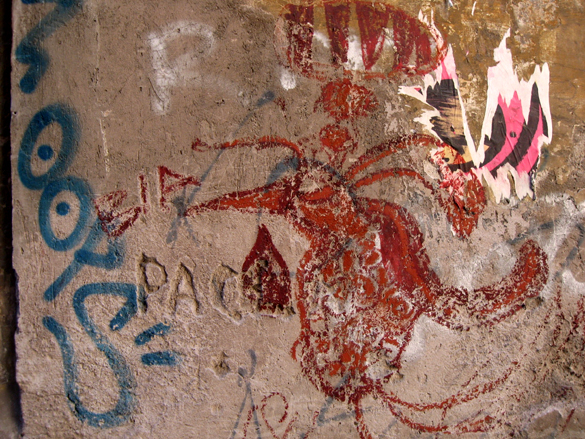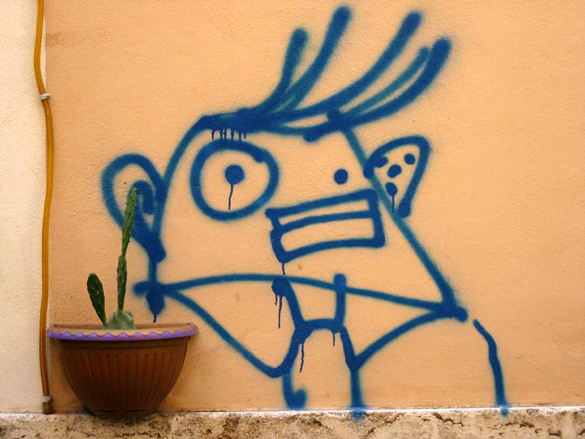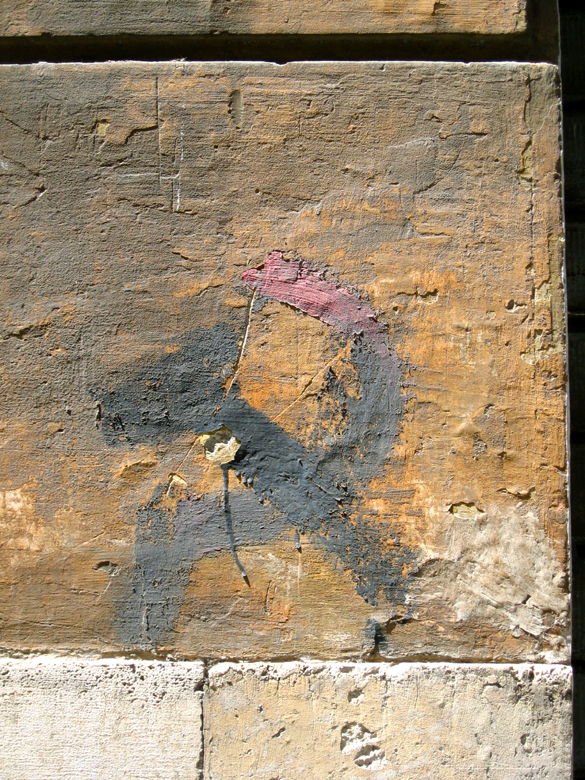Each and every ground-level wall in Rome carries some scratching, scribbling, scrawling or spraying. Suffering enough from lack of public spending, the Italian capital is made only shabbier and sadder by the ubiquitous graffiti. This is vandalism on a grand scale.
But, up close, individual pieces are fascinating. Is this beautiful stuff? You don’t know who the “perpetrator” is. (Interestingly, one assumes that it is a young male!) What he is saying and to whom may not be obvious either. It may be a targeted insult, a statement of “this is our patch,” a declaration of love or support for a political movement. The media vary and may even date their application. Obviously, the older and more durable involve chipping or scratching into the wall whilst the newer and less durable are paint and chalk. Old and new alike submit to the flaking and crumbling of Rome’s backstreet walls. The result is something raw, mysterious, time-sensitive and even elegant. There is such a concentration of these pieces that they overlap and a chronology can be deduced. At the end of a long hot day and having walked the city for kilometres, I feel these walls proffer a glimpse into the soul of today’s Rome.
“PACE” is scratched deep into a repaired wall: a plea for peace dating back to World War II? A bizarre red and orange cockerel-like figure with an undecipherable thought-bubble is painted after the faded white spray paint and after a poster has been torn down. Blue spray last? Oops!
The clean beige paint on this section of wall without doubt covers other graffiti. The opportunistic wielder of a blue spray-can chooses to attack this fresh surface but meticulously respects the margins given by the cactus pot and the marble ledge. Is the Dilbert-like character with tie, spotty left ear and rectangular lips an uncle, a neighbour or a politician?
This hammer and sickle was probably painted during the cold war. Does the red tip of the sickle signify a bloody revolution to come? Or Mussolini’s blood?
Recently (February 2013), a purported Bansky “mural” in London has been taken – on its wall – for sale in Miami for US$ gazillions.




Graffiti. The word still glows hot from the crucible from which it was forged, namely the ancient Mediterranean world. Taken from classical Greek it evolved through Latin into modern Italian which makes me wonder if it is by design or coincidence that your examples are from Rome. It is my belief that the general understanding of graffiti is that it is the result of defacing, by writing or creating images, of something belonging to another who gives no permission for that defacing to take place. Graffiti is found from the walls of ancient Pompeii to the Subway trains of New York City and no doubt it will follow Humankind to other Planets in the future! It is created with many mediums from scratching to the ubiquitous spray can. Graffiti carries the negative charge of a criminal act and is infected by its own generally accepted ugliness. It is described as a crime of Criminal Damage in England, Malicious Mischief in Scotland and is no doubt given space in most societies’ criminal legislation. Even in lawless times and places rough justice would have been meted out to perpetrators of graffiti. After all, how would you feel if someone put graffiti on your property? In the UK Police and Government have designated graffiti as a “Trigger Offence”. If left unchecked it destroys the quality of the environment, triggering a downward spiral of crime and loss of confidence by communities and individuals. Having said this I have to admit to being enormously attracted to and excited by the vandalised cityscape. For me such places are where I can experience the dark side of Human Nature and thus enhance my experience, knowledge and wisdom thus making me better at survival. Well, that is my explanation for this appreciation of something others might consider just unpleasant. Because I see reason behind my attraction to the vandalised cityscape it becomes symbolic of excitement and the pleasure that brings me and therefore beautiful in a perverse way.
So why are we discussing graffiti here on Talking Beautiful Stuff? In spite of what I have said above I would actually like to punch the perpetrators of this selfish, costly and at times cruelly devastating activity in the face! I recognise that I probably need to emphasise at this point that I am aware that all I write is, of course, just my opinion but generally I find nothing beautiful in the vast majority of graffiti, on an individual basis, and would consign that portion, which includes your examples, to the ugly dustbin. However, go to the Saint-Georges and Jonction area of your own city of Geneva and you will see rare examples of graffiti that consist of illustrations and writings of a mature and considered nature. These I have stood before and found myself in admiration of the skill of the creators of these works. I am a professional illustrator and therefore feel qualified to understand and appreciate the skills and practice needed to reach that standard of maturity and consideration in one’s work. I think I might be talking beautiful stuff here!
I am trying to follow the “House Rules” of TBS so the above is what your examples mean to me and, I hope, covers what is being created, when and how. The rules also require discussion on who is creating and for who it is being created. This is difficult to condense down to a few lines but I believe that graffiti is generally a statement by the disadvantaged created to be seen by all in order to satisfy a desire to tell, although sometimes much veiled or obtuse, of perceived injustices. It occurs to me that as graffiti speaks of perceived ugliness then this is reflected in the work of the creator. It must be so that the creators justify their criminal actions, as all criminals do, or they would be heavily laden with guilt. I think that this is evidential for my argument that it is indeed the perceived injustices that allow the creators of graffiti to do it without remorse. I think this theory of the creators being disadvantaged is a good starting point or base which allows for the diverse and complex reasons for graffiti to be evolved out of it. These include reasons such as gang slogans for territorial marking, self or political proclamation, sympathy for the disadvantaged or just the need to destroy the world that has caused those perceived injustices.
I have to conclude (“thank goodness” you are saying) that if fighting injustice is a beautiful thing and a fine piece of work is created to do this then we have to be talking Beautiful Stuff. Even if we do not hold with the view of the creator we might appreciate the principle he or she is using to justify the work. Criminal acts are justified as done in the name of justice every day. There is a saying that one man’s terrorist is another’s freedom fighter. If we can find, through contemplation, beauty in graffiti, can we not create a better world around us by contemplating why the disadvantaged are so, evaluate without prejudice their point of view and try to discover what can be done about their situations? If we can do this might graffiti one day be a thing of the past and therefore there would be no point discussing it!
Thanks for your thoughtful reply! Food for thought… Cheers, Isaac